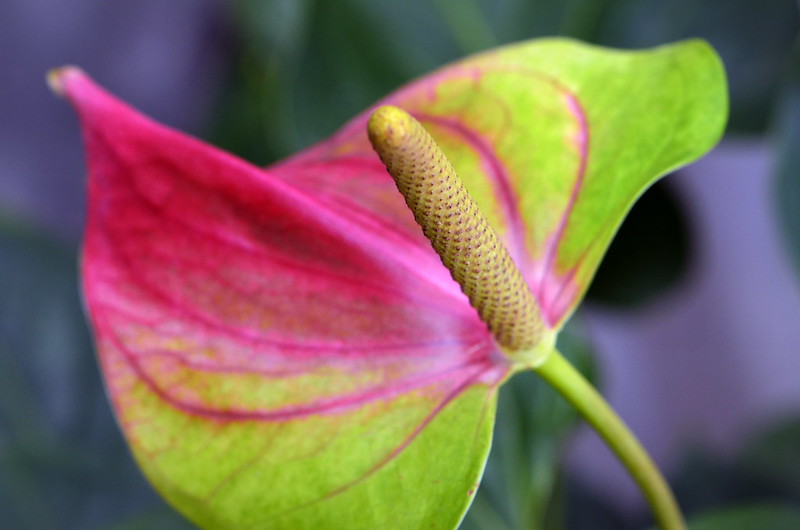There are two plant parts that are frequently found together whose names I quite like: “spathe” and “spadix.” The two words evoke something mysterious, almost like “cloak” and “dagger.” In fact, there is an element of danger when it comes to plants that have both spathes and spadices, such as Anthuriums, Calla Lilies, and the fabulous Titan Arum (also known as the Corpse Flower because it smells like rotting flesh): they are all poisonous. Their sap contains needle-like calcium oxalate crystals, which can cause significant pain and swelling if an unwitting animal happens to take a bite of the plant. Ingesting large amounts can be fatal because the swelling can make swallowing and breathing difficult–but most animals quickly learn to stay far away. The plants have an excellent defense system.
Toxicity aside, plants with spathes and spadices are striking, as evidenced by this Anthurium andreanum ‘Fantasy Love,’ which is a member of the Arum family (Araceae, aka the aroids). This Anthurium may want to repel herbivores, but it also wants to attract pollinators and one way to do that is via the colorful spathe.

The spathe looks like a petal, but it is actually a bract–a modified leaf. It helps get pollinators closer to the actual flowers, which are tiny and are located in spirals on the spadix. Here is a close-up view of an Anthurium spadix–the stigmas on the almost microscopic white female flowers are emitting a fluid that indicates the flowers are ready to be pollinated. If pollination is successful, the spadix will produce little fruits (or berries) containing seeds.

Sometimes spathes are open and fairly flat, as with the Anthurium above, but they can also encase the spadix and appear funnel like, as with Calla lilies. The photo below is an internal view of my neighbor’s ‘Calypso’ Calla lily–with the deep-red spathe almost entirely surrounding the spadix.

One last fun fact: some spadices in the Arum family can produce a lot of heat in cold weather, reaching temperatures significantly warmer than the surrounding air temperature. The Titan Arum is one of them. This ability is yet another way the plants attract pollinators. A warm spadix does two things: it provides pollinators with a bit of energy in chilly weather and it acts as a fragrance diffuser, wafting that delicious putrid odor just a bit further as an added enticement. So if you are a pollinator, you get a colorful, warm, and nice smelling (ok, odoriferous) welcome. If you are a herbivore, you come under chemical attack. Isn’t nature great?








2 Responses to “Spathe and Spadix”